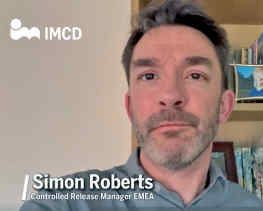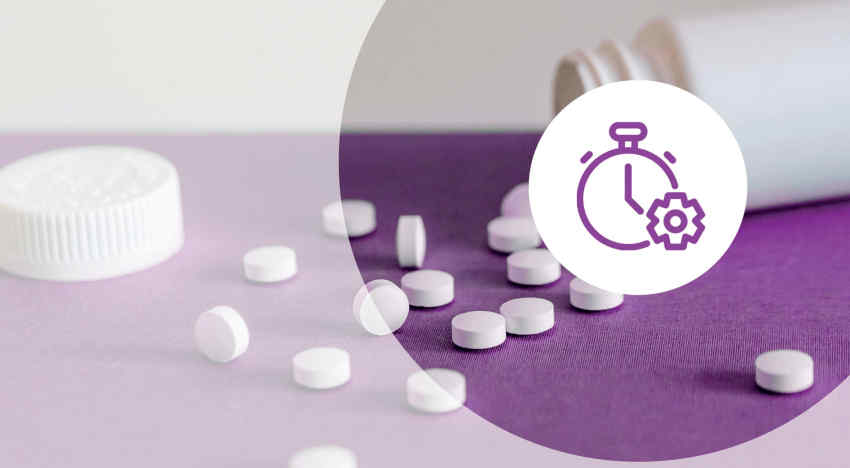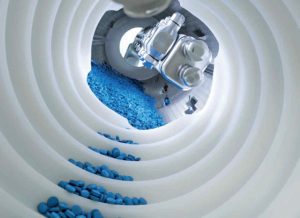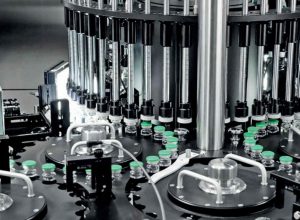
Controlled release drug delivery systems are designed to deliver the drug at a predetermined rate for a specified period of time. The drivers for development of such controlled release delivery systems include maintaining therapeutic drug plasma levels; providing reduced dosing frequency; minimizing side-effects; improving patient compliance and targeting delivery to specific sites or time points. Development of controlled release products can therefore be challenging. The most commonly used technology for controlled release drug delivery is the hydrophilic matrix tablet. Hydrophilic matrix tablets have an excellent safety record which can provide reproducible release profiles from well designed formulations. Release profiles can be modified through choice of the release modifying polymer and the selection of other excipients. Additionally CR products can be manufactured on standard tablet production equipment.
Drug release from hydrophilic matrix tablets
In a hydrophilic matrix tablet, the drug substance is combined with a hydrophilic polymer and other excipients. The drug is released via diffusion and/or erosion from the swollen polymer matrix. The primary release mechanism is influenced by the properties of the drug substance. A drug substance with high solubility will primarily be released via diffusion through the swollen matrix, whereas a drug substance with limited solubility will be held within the matrix until it released via the erosion of the matrix. There are a number of different polymers available that can be used in hydrophilic matrix tablets. Hypromellose (HPMC) is the most commonly used polymer.
Optimising CR Formulations with Hypromellose
Hypromellose is available in a number of different types, differing in the levels of substitution on the cellulose backbone. The different types are shown in Table 1.
| Hypromellose
(USP-NF/Ph Eur/JP) |
Methoxyl substitution | Hydroxypropoxyl substitution | Product grades from Roquette Pharma Solutions |
| 2910 | 28-30 % | 7-12 % | Methocel™ E Premium |
| 2906 | 28-30 % | 4-8 % | Methocel™ F Premium |
| 2208 | 19-24 % | 7-12 % | Methocel™ K Premium CR |
Table 1: Hypromellose Pharmacopeia Designations
The changes in substitution on the cellulose backbone result in different swelling and gel properties. Hypromellose 2208, Methocel™ K types, produce the most robust hydrophilic matrices, which make it the most often used type of HPMC in CR Matrix tablets. Suvsequesnt discussions will focuson Hypromellose 2208.
The critical formulation variables to consider when formulating a CR hydrophilic matrix tablet with HPMC are:
- Drug Substance Solubility – high or low
- HPMC properties – viscosity, content & particle size
- Filler material properties – soluble or insoluble
As discussed previously, the solubility of the drug substance. high or low, influences the mechanism of release from the hydrophilic matrix. For a highly soluble drug substance, where the primary mechanism of release is diffusion through the matrix, a high viscosity HPMC, such as Methocel™ K100M Premium CR (Roquette Pharma Solutions), should be selected to offer the greatest diffusion barrier. On the other hand, for a drug substance with low solubility, a low viscosity HPMC, such as Methocel™ K100LV Premium CR (Roquette Pharma Solutions), should be selected to allow release via erosion of the HPMC matrix. The second consideration should be the quantity of HPMC included within the formulation. It is essential to form a homogenous and robust gel barrier to provide the required drug release from the hydrophilic matrix. If the amount of HPMC is too low, the resultant matrix will not form a coherent barrier in the initial phase of swelling, and will subsequently not retain its integrity, resulting in drug release that is too fast and more variable. At an HPMC content of 30 wt.% in the tablet formulation a coherent gel barrier forms rapidly in the first few minutes of dissolution. Consistent, repeatable drug profiles are then generated as the swelling and erosion fronts move through the tablet. At higher levels of HPMC the benefit of slower drug release is reduced and the increasing tablet size is not desirable. Therefore, the optimum content of HPMC in a CR hydrophilic matrix tablet is 30 wt.%.
Formation of the gel barrier in the first few minutes of dissolution is controlled by the content and particle size of the HPMC. If the particle size is too large, above 200 µm, the swelling of the HPMC particles is too slow and a robust gel barrier does not form resulting in a weaker matrix. Rapid formation of the gel barrier and resultant robust matrices are formed using HPMC with a particle size typically below 150 µm. Methocel™ Premium CR grades from Roquette Pharma Solutions have a controlled particle size to ensure robust CR matrices every time.
The rate of drug release can be further influenced by the properties of other formulation excipients. A soluble filler such as lactose or mannitol will increase the rate of drug release. The increased drug release is a result of diffusion of the soluble filler from with the matrix, creating pores which reduces the integrity of the matrix leading to faster diffusion and erosion release of the drub substance. Conversely, an insoluble filler such as dicalcium phosphate or microcrystalline cellulose will have a slower rate of drug release.
Conclusions
Robust, consistent hydrophilic matrix CR formulations can be prepared by following simple guidance. Choose the correct viscosity of HPMC based upon the drug substance solubility. Ensure an HPMC content of 30% in the tablet formulation. Control the particle size through selection CR grades such as Methocel™ K Premium CR from Roquette Pharma Solutions. Be aware of the influence of the filler properties on the final drug release profile.

Katerina Chuienko
Sales Manager Pharmaceuticals
IMCD Ukraine Shovkovychna street 42-44, 3d floor, off 303 • 01024 Kyiv • Ukraine
M +38 067 823 0210




